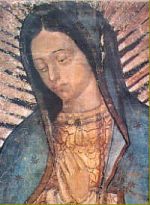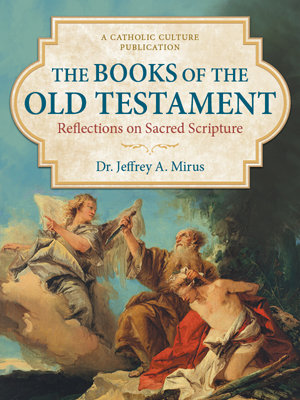Introduction to the Liturgical Year
By Dr. Jeff Mirus ( bio - articles - email ) | Oct 05, 2011
The Church inculcates Christ and His mission through the patterns and rhythms of her Liturgical Year. She is herself the universal sacrament of salvation and the visible manifestation on earth of the presence of the Kingdom of God even now. But the Church also has various ministries and means by which she carries out her special mission. The Liturgical Year is perhaps the most important means she uses to sanctify the concept of time itself.
During the course of the Liturgical Year, the saving actions of Christ are presented again to the Faithful in an effective spiritual sequence that provides occasions for deepening our experience of Christ, for giving scope to our need for fasts and feasts, penance and joy, the remission of sin and the foretaste of heavenly glory. The annual cycle invites us to live the Christian mysteries more deeply, to let the Christ-life seep into our very bones, and in so doing to transform and renew all human endeavors, all human culture.
The backbone of the Liturgical Year is the Liturgical Calendar, an annual cycle of seasons and feasts which both commemmorate and invite us to more fully enter into the real history of our salvation. At the same time, the days devoted to the celebration of many of the Church’s saints provide us with inspiring models of what it means to exemplify the love and virtues which Our Lord and Savior so zealously wishes us to share. In this way, we may develop in and through time a heart like unto His own.
On the CatholicCulture.org website, we have collected and organized a great many resources for helping all of us to live the Liturgical Year more consciously and more actively. In addition to the accounts of the nature, history and purposes of the great feasts, and of course the lives of the saints, we have brought together a wide variety of customs for celebrating the various seasons and feasts which have grown up in cultures throughout the world. And in connection with these customs, we have also collected appropriate prayers and devotions, family activities, and even receipes—the better to help us taste and see the glory of the Lord! (Ps 34:8)
All of these resources are organized according to the Liturgical Calendar, and many of them are deliberately oriented toward use by the family, or what recent popes have referred to as the domestic church. The family is to be the Church in miniature, the first of all Christian communities, the warm embrace in which new souls are claimed for Christ and nourished in every way for His service. The family is also the source of the Church’s manifold vocations, including the vocations of those who dedicate themselves exclusively to Christ and the Church’s service as priests and religious. Thus, in every way, the Church public, the Church as a whole, the mystical body of Christ in its fulness, depends on the health and strength of the domestic church, even as she nourishes the domestic church through her presence, her sacraments, her counsel, her teaching—and, of course, her Liturgical Year.
It is not possible in an eBook to reproduce the full richness and flexibility of these resources as they are presented on our website (www.catholicculture.org). The visual displays of eBooks cannot, in most cases, equal those of web pages, and it is generally not as easy to follow the many links available to explore the full range of offerings. What we have done in the volumes of this series is to present the days of the Liturgical Year in sequence, grouped in their proper seasons, so that the user can follow the unfolding of the Liturgical Year with immediate access to the meaning of each day, complete with its spiritual and liturgical explanations, and its biographies of the saints. Following the basic presentation for each day are many links to additional information, prayers, activities and recipes which relate specifically to that day or the Season as a whole.
These materials can be used with profit by anyone. However, if we were to offer specific advice to parents on how they may make the best use of all the resources in their own families, we would emphasize the following two points:
First, remember that all of us, but especially children, grow spiritually when we have the opportunity to associate living examples, customs and activities with God’s love and saving power. This sort of participation helps children to learn the Faith along with their mother’s milk, so to speak—or, as we said above, to get it into their very bones. Children also need heroes, and one way or another they will find them. The saints make the best of all possible heroes.
Second, avoid trying to do too much. Select carefully and emphasize a few things that you believe will work well in your situation. Keep your attitude joyful and relaxed. With a little judicious planning, let your family’s own customs grow and develop over time. Much of this will be carried on for generations to come, generations which trace their own faith to and through you.
A word, finally, on the sources of much of the material presented both in this eBook and on the much larger web site. Many of these wonderful books are, sadly, out of print, but we owe a great debt to them. You may enjoy pursuing some of these sources on your own. The years listed are the original publication dates; some have gone through multiple editions. They include:
- Berger, Florence. Cooking for Christ (National Catholic Rural Life Conference) 1949
- Burton, Katherine and Helmut Ripperger. The Feast Day Cookbook, 1951
- Butler, Alban. Butler’s Lives of the Saints (updated since the 18th century, up to 12 volumes depending on edition)
- Congregation for Divine Worship and the Discipline of the Sacraments. Directory on Popular Piety and the Liturgy 2002
- Gueranger, OSB (Abbot). The Liturgical Year, 1983
- Kelly, Fr. George A. Catholic Family Handbook, 1959
- Lodi, Enzo. Saints of the Roman Calendar, 1993
- McLoughlin, Helen. My Nameday—Come for Dessert, 1962
- Mueller, Therese. Our Children’s Year of Grace, 1943
- Newland, Mary Reed. Saints and Our Children, 1958
- Newland, Mary Reed. We and Our Children, 1954
- Newland, Mary Reed. The Year and Our Children, 1956
- Parsch, Dr. Pius. The Church’s Year of Grace (5 volumes), 1953
- Trapp, Maria Augusta. Around the Year with the Trapp Family, 1955
- Weiser, Francis X., SJ. The Easter Book, 1954.
May you find in this series of volumes on the Liturgical Year a true gateway to the riches of Christ!
All comments are moderated. To lighten our editing burden, only current donors are allowed to Sound Off. If you are a current donor, log in to see the comment form; otherwise please support our work, and Sound Off!








